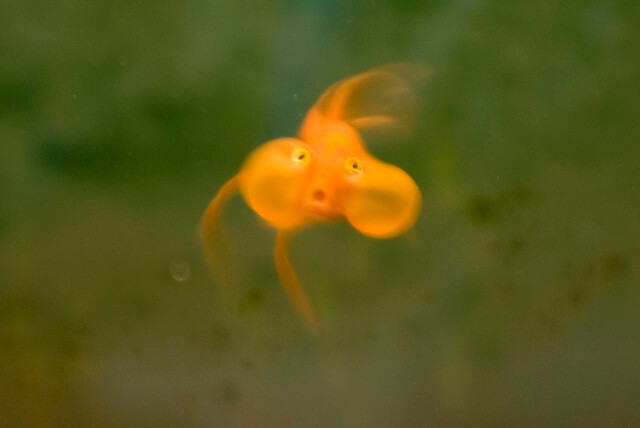Introduction: The bubble eye goldfish is a captivating and delicate fancy goldfish breed known for its distinctive fluid-filled sacs or pouches that protrude from its cheeks. In this comprehensive guide, we will explore the characteristics of bubble eye goldfish and provide essential insights on how to properly care for these charming aquatic companions.

Unique Features of Bubble Eye Goldfish
Bubble eye goldfish are easily recognized by their upward-pointing eyes, reminiscent of the celestial goldfish. Their body shape and fins are also similar to the celestial goldfish, with a graceful and elegant appearance. However, what truly sets the bubble eye goldfish apart are the fluid-filled sacs or pouches that hang below their eyes. These delicate pouches, filled with water or air, give them their distinctive bubble-like appearance. High-quality bubble eye goldfish will have two equally developed and symmetrical pouches.
Care Tips
Creating a suitable environment is crucial for the well-being of bubble eye goldfish. Consider the following factors when setting up their tank:
Tank Size
Provide ample space for bubble eye goldfish to swim and explore. A minimum tank size of 20 gallons is recommended for a single bubble eye, with additional space for each additional goldfish.
Tank Decorations
Opt for smooth and rounded decorations to minimize the risk of injury to the delicate pouches. Avoid sharp edges or rough surfaces that could potentially puncture or damage the sacs. Live or artificial plants, smooth rocks, and soft substrate are ideal choices.
Filtration and Water Flow
Use gentle filtration systems and adjust the water flow to create a calm and low-current environment. Strong currents can cause stress and damage to the pouches. Consider sponge filters or adjustable flow filters to maintain suitable water conditions.
Lighting
Bubble eye goldfish have poor eyesight, so it is important to provide adequate lighting without causing excessive glare or brightness. Low-wattage aquarium lights are recommended to create a comfortable environment for your goldfish.
Tank Mates and Compatibility
Bubble eye goldfish are slow swimmers with limited vision, making it important to select tank mates carefully. Ideal companions include other delicate and slow-moving goldfish breeds such as the celestial goldfish, pompon goldfish, ranchu goldfish, or telescope goldfish. Avoid introducing fast-swimming or aggressive species that may outcompete or cause stress to the bubble eye goldfish.
Water Temperature and Maintenance
Bubble eye goldfish are best kept in aquariums with water temperatures ranging from 65°F to 75°F (18.3°C to 23.9°C). Regularly monitor water parameters such as pH, ammonia, nitrite, and nitrate levels to ensure a healthy environment. Perform regular water changes to maintain water quality and remove accumulated waste.
Feeding and Nutrition
Provide a balanced and varied diet to ensure the health and vibrancy of your bubble eye goldfish. Offer a combination of high-quality goldfish pellets or flakes, supplemented with occasional treats such as freeze-dried or frozen foods like bloodworms or brine shrimp. Avoid overfeeding to prevent digestive issues and obesity.
Conclusion
Caring for bubble eye goldfish requires attention to their unique physical attributes and specific environmental needs. By creating a suitable tank setup, choosing compatible tank mates, maintaining proper water conditions, and providing a balanced diet, you can ensure the well-being and longevity of your bubble eye goldfish. With their charming appearance and gentle nature, these delicate aquatic companions will undoubtedly bring joy and tranquility to your home aquarium.
Sources:
- Alderton, D. (2008). Goldfish: A Complete Introduction. Firefly Books.
- Stoskopf, M. (1993). Goldfish Varieties and Genetics: A Handbook for Breeders. T.F.H. Publications.
Reviewed By: Tim Winter

Tim Winter has a strong affection for pets and wildlife. His years of experience caring for various types of pets has led him to share his knowledge with others on the best practices in pet care. Tim holds a Bachelor of Science from the University of Oregon School of Journalism and Communications.
